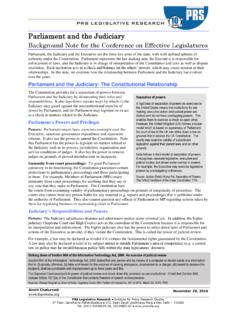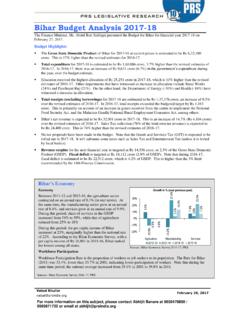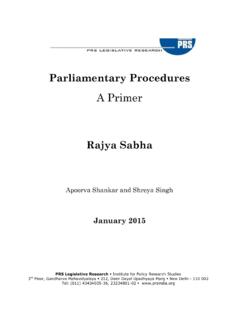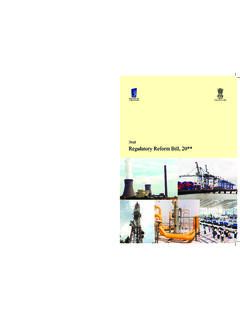Transcription of Summary Swaminathan report - PRS | Home
1 report Summary Swaminathan Committee on Farmers (October 2006) Background The National Commission on Farmers (NCF) was constituted on November 18, 2004 under the chairmanship of Professor Swaminathan . The Terms of Reference reflected the priorities listed in the Common Minimum Programme. The NCF submitted four reports in December 2004, August 2005, December 2005 and April 2006 respectively. The fifth and final report was submitted on October 4, 2006. The reports contain suggestions to achieve the goal of faster and more inclusive growth as envisaged in the Approach to 11th Five Year Plan. Terms of Reference The NCF is mandated to make suggestions on issues such as: (a) a medium-term strategy for food and nutrition security in the country in order to move towards the goal of universal food security over time; (b) enhancing productivity, profitability, and sustainability of the major farming systems of the country; (c) policy reforms to substantially increase flow of rural credit to all farmers; (d) special programmes for dryland farming for farmers in the arid and semi-arid regions, as well as for farmers in hilly and coastal areas; (e) enhancing the quality and cost competitiveness of farm commodities so as to make them globally competitive; (f) protecting farmers from imports when international prices fall sharply.
2 (g) empowering elected local bodies to effectively conserve and improve the ecological foundations for sustainable agriculture; Key Findings and Recommendations Causes for farmers distress Agrarian distress has led farmers to commit suicide in recent years. The major causes of the agrarian crisis are: unfinished agenda in land reform, quantity and quality of water, technology fatigue, access, adequacy and timeliness of institutional credit, and opportunities for assured and remunerative marketing. Adverse meteorological factors add to these problems. Farmers need to have assured access and control over basic resources, which include land, water, bioresources, credit and insurance, technology and knowledge management, and markets. The NCF recommends that Agriculture be inserted in the Concurrent List of the Constitution.
3 Land Reforms Land reforms are necessary to address the basic issue of access to land for both crops and livestock. Land holdings inequality is reflected in land ownership. In 1991-92, the share of the bottom half of the rural households in the total land ownership was only 3% and the top 10% was as high as 54%. Table 1: Distribution of Land Land Holding % of Households % of Land hold Land less Sub-margin holdings ( acres) Marginal holdings [ acres] Small holdings [ acres] Medium holdings [ acres] Large holdings [15 acre +above] Source: Table 1 of the Fifth NCF report based on Some Aspects of Household Ownership Landholdings-1991-92. NSS report -399 Some of the main recommendations include: Distribute ceiling-surplus and waste lands; Prevent diversion of prime agricultural land and forest to corporate sector for non-agricultural purposes.
4 Ensure grazing rights and seasonal access to forests to tribals and pastoralists, and access to common property resources. Establish a National Land Use Advisory Service, which would have the capacity to link land use decisions with ecological meteorological and marketing factors on a location and season specific basis. Set up a mechanism to regulate the sale of agricultural land, based on quantum of land, nature of proposed use and category of buyer. Irrigation Out of the gross sown area of 192 million ha, rainfed agriculture contributes to 60 per cent of the gross cropped area and 45 per cent of the total agricultural output. The report recommends: A comprehensive set of reforms to enable farmers to have sustained and equitable access to water. Increase water supply through rainwater harvesting and recharge of the aquifer should become mandatory.
5 Million Wells Recharge programme, specifically targeted at private wells should be launched. Substantial increase in investment in irrigation sector under the 11th Five Year Plan apportioned between large surface water systems; minor irrigation and new schemes for groundwater recharge. Productivity of Agriculture Apart from the size of holding, the productivity levels primarily determine the income of the farmers. However, the per unit area productivity of Indian agriculture is much lower than other major crop producing countries. Table 2: Comparative Yield of Select Crops in Various Countries (Kg/ha) Crop Country Paddy Wheat Maize Groundnut Sugarcane India 2929 2583 1667 913 68012 China 6321 3969 4880 2799 85294 Japan 6414 - - 2336 - USA 6622 2872 8398 3038 80787 Indonesia 4261 - 2646 1523 - Canada - 2591 7974 - - Vietnam 3845 2711 4313 1336 65689 Source: Table 3 of the Fifth NCF report based on Agriculture At a Glance [2002] Ministry of Agriculture In order to achieve higher growth in productivity in agriculture, the NCF recommends: Substantial increase in public investment in agriculture related infrastructure particularly in irrigation, drainage, land development, water conservation, research development and road connectivity etc.
6 A national network of advanced soil testing laboratories with facilities for detection of micronutrient deficiencies. Promotion of conservation farming, which will help farm families to conserve and improve soil health, water quantity and quality and biodiversity. Credit and Insurance Timely and adequate supply of credit is a basic requirement of small farm families. The NCF suggests: Expand the outreach of the formal credit system to reach the really poor and needy. Reduce rate of interest for crop loans to 4 per cent simple, with government support. Moratorium on debt recovery, including loans from non-institutional sources, and waiver of interest on loans in distress hotspots and during calamities, till capability is restored. Establish an Agriculture Risk Fund to provide relief to farmers in the aftermath of successive natural calamities.
7 Issue Kisan Credit Cards to women farmers, with joint pattas as collateral. Develop an integrated credit-cum-crop-livestock-human health insurance package. Expand crop insurance cover to cover the entire country and all crops, with reduced premiums and create a Rural Insurance Development Fund to take up development work for spreading rural insurance. Promote sustainable livelihoods for the poor by improving (i) Financial services (ii) Infrastructure (iii) Investments in human development, agriculture and business development services (including productivity enhancement, local value addition, and alternate market linkages) and (iv) Institutional development services (forming and strengthening producers organisations such as self-help groups and water user associations). Food Security The Mid-term appraisal of the 10th Plan revealed that India is lagging behind in achieving the Millennium Development Goals of halving hunger by 2015.
8 Therefore, the decline in per capita foodgrain availability and its unequal distribution have serious implications for food security in both rural and urban areas. The proportion of households below the poverty line was 28% in 2004-05 (close to 300 million persons). However, in 1999-2000, the percentage of population consuming diets providing less than 2400 kcal (underlines definition of below poverty line) per capita per day was almost 77% of the rural population. Several studies have shown that the poverty is concentrated and food deprivation is acute in predominantly rural areas with limited resources such as rain-fed agricultural areas. The report recommends: Implement a universal public distribution system. The NCF pointed out that the total subsidy required for this would be one per cent of the Gross Domestic Product.
9 Reorganise the delivery of nutrition support programmes on a life-cycle basis with the participation of Panchayats and local bodies. Eliminate micronutrient deficiency induced hidden hunger through an integrated food cum fortification approach. Promote the establishment of Community Food and Water Banks operated by Women Self-help Groups (SHG), based on the principle Store Grain and Water everywhere . Help small and marginal farmers to improve the productivity, quality and profitability of farm enterprises and organize a Rural Non-Farm Livelihood Initiative. Formulate a National Food Guarantee Act continuing the useful features of the Food for Work and Employment Guarantee programmes. By increasing demand for foodgrains as a result of increased consumption by the poor, the economic conditions essential for further agricultural progress can be created.
10 Prevention of Farmers Suicides In the last few years, a large number of farmers have committed suicide. Cases of suicides have been reported from states such as Andhra Pradesh, Karnataka, Maharashtra, Kerala, Punjab, Rajasthan, Orissa and Madhya Pradesh. The NCF has underlined the need to address the farmer suicide problem on a priority basis. Some of measures suggested include: Provide affordable health insurance and revitalize primary healthcare centres. The National Rural Health Mission should be extended to suicide hotspot locations on priority basis. Set up State level Farmers Commission with representation of farmers for ensuring dynamic government response to farmers problems. Restructure microfinance policies to serve as Livelihood Finance, credit coupled with support services in the areas of technology, management and markets.















